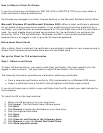
AES-CCMP Advanced Encryption Standard - Counter CBC-MAC Protocol is the new
method for privacy protection of wireless transmissions specified in the
IEEE 802.11i standard. AES-CCMP provides a stronger encryption method
than TKIP.
Authentication Verifies the identity of a user logging onto a network. Passwords, digital
certificates, smart cards and biometrics are used to prove the identity of
the client to the network. Passwords and digital certificates are also used
to identify the network to the client.
BER
Bit error rate. The ratio of errors to the total number of bits being sent in a
data transmission from one location to another.
Bit Rate The total number of bits (ones and zeros) per second that a network
connection can support. Note that this bit rate will vary, under software
control, with different signal path conditions.
Broadcast
SSID
Used to allow an access point to respond to clients on a wireless network
by sending probes.
BSSID A unique identifier for each wireless client on a wireless network. The Basic
Service Set Identifier (BSSID) is the Ethernet MAC address of each adapter
on the network.
CA (certificate
authority)
A corporate certification authority implemented on a server. In addition,
Internet Explorer’s certificate can import a certificate from a file. A trusted
CA certificate is stored in the root store.
CCX Cisco Compatible eXtension. Cisco Compatible Extensions Program ensures
that devices used on Cisco wireless LAN infrastructure meet the security,
management and roaming requirements.
Certificate Used for client authentication. A certificate is registered on the
authentication server (i.e., RADIUS server) and used by the authenticator.
CKIP Cisco Key Integrity Protocol (CKIP) is a Cisco proprietary security protocol
for encryption in 802.11 media. CKIP uses a key message integrity check
and message sequence number to improve 802.11 security in
infrastructure mode. CKIP is Cisco's version of TKIP.
Client
computer
The computer that gets its Internet connection by sharing either the host
computer's connection or the Access Point's connection.
DSSS Direct Sequence Spread Spectrum. Technology used in radio transmission.
Incompatible with FHSS.
EAP Short for Extensible Authentication Protocol, EAP sits inside of Point-to-
Point Protocol’s (PPP) authentication protocol and provides a generalized
framework for several different authentication methods. EAP is supposed
to head off proprietary authentication systems and let everything from
passwords to challenge-response tokens and public-key infrastructure
certificates all work smoothly.
EAP-FAST EAP-FAST, like EAP-TTLS and PEAP, uses tunneling to protect traffic. The
main difference is that EAP-FAST does not use certificates to authenticate.


















